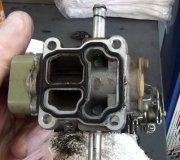Then you're going to need a scanner to view live data. The thing you need to see is "AIS steps". That is the step, from "0" to "256" the computer has placed the automatic idle speed motor to. For a good-running engine, step 32 is typical. If you find it on step 0, it hasn't learned minimum throttle yet. Try coasting while holding the brake pedal up with your toes. If that works, the brake light switch is out-of-adjustment or has an intermittent contact. The additional clue is often the lack of the idle flare-up at engine start-up.
If you find the idle step to be around "50", that is typical of a single-cylinder misfire. When slowing down, the computer may not respond fast enough to prevent the engine from stalling. If no misfire is felt, or detected by the computer, you might look at a fuel pressure problem. Usually that causes other symptoms but you don't want to overlook that.
You can also use the scanner to run the engine idle speed up to 2000 rpm in 200 rpm increments. That will prove the idle speed motor is working and the air passage isn't blocked with carbon. We don't run into that much anymore with the better fuel additives. If you see the throttle plate inside the throttle body is heavily coated with black carbon, wash that off with carburetor cleaner in a spray can.
Also look at the map sensor voltage. It has the biggest say in how much fuel is commanded from the injectors. Usually they fail completely over the course of less than a day, and their failure rate is extremely low compared to the early '90s, but while they're in the process of failing, they can develop the wrong signal voltage that is still within the acceptable limits. It has to go to 0.0 or 5.0 volts to set a fault code and turn on the Check Engine light. With any reading between the normal, (approximate), 0.5 to 4.5 volts, the computer will deliver fuel based on that reading even though it might be wrong.
Tuesday, December 11th, 2012 AT 3:16 AM


